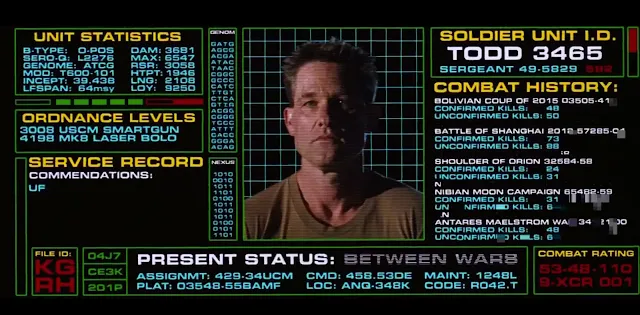One way in which Blade Runner and Soldier are connected is through their shared creative team. David Peoples, who co-wrote Blade Runner, also wrote Soldier, while David L. Snyder served as production designer for both films.
These connections suggest that Soldier was possibly created with Blade Runner in mind, even if the two films have different characters and storylines.
Furthermore, the two films share thematic similarities. Both explore the nature of humanity and what it means to be human.
The Soldier, Todd participated in campaigns at Tannhäuser Gate and the Shoulder of Orion. These were both referenced by Roy Batty during his Tears in the Rain monologue at the end of Blade Runner shortly before his death.
 |
| Kurt Russell (The Thing, Escape from New York) stars as the Soldier |
Furthermore, the two films share thematic similarities. Both explore the nature of humanity and what it means to be human.
Blade Runner focuses on replicants, who are artificially created beings that are nearly indistinguishable from humans, while Soldier focuses on genetically enhanced soldiers who have been bred for combat. Both films question whether these artificial beings can truly be considered human and what it means to be alive.
Soldier contains explicit 4 references to Blade Runner.
The Soldier, Todd participated in campaigns at Tannhäuser Gate and the Shoulder of Orion. These were both referenced by Roy Batty during his Tears in the Rain monologue at the end of Blade Runner shortly before his death.
Todd also participated in the Battle of Argentine Moons, a location referenced previously in the Marvel comics adaptation of Blade Runner.
A Spinner flying car is observed:
These references suggest that Soldier takes place in a world that has been shaped by the events of Blade Runner, further connecting the two films.
Which is cool and all but I just liked it when the Soldier saved the kid...
Despite these connections, Soldier is not a direct sequel to Blade Runner. Instead, it serves as a "sidequel," existing in the same universe and sharing a common narrative thread. This allows the two films to be viewed independently while still being connected to each other.
In addition to the shared creative team and thematic similarities, there are several other interesting connections between Blade Runner and Soldier.
For example, both films were directed by filmmakers who were heavily influenced by the works of Ridley Scott. Ridley Scott directed Blade Runner, and Soldier director Paul W.S. Anderson (Event Horizon), has cited Blade Runner as a major influence on his filmmaking style. This connection further reinforces the idea that Soldier was created with Blade Runner in mind.
Another interesting connection is the use of futuristic technology in both films. Blade Runner showcases advanced technologies like flying cars, artificial intelligence, and genetically engineered humans, while Soldier features advanced weapons, advanced medical technologies, and genetically enhanced soldiers. This use of technology in both films is a reflection of the filmmakers' shared interest in exploring the potential consequences of technological advancements on humanity.
The films are of course completely different in many respects.
Despite these connections, Soldier is not a direct sequel to Blade Runner. Instead, it serves as a "sidequel," existing in the same universe and sharing a common narrative thread. This allows the two films to be viewed independently while still being connected to each other.
In addition to the shared creative team and thematic similarities, there are several other interesting connections between Blade Runner and Soldier.
For example, both films were directed by filmmakers who were heavily influenced by the works of Ridley Scott. Ridley Scott directed Blade Runner, and Soldier director Paul W.S. Anderson (Event Horizon), has cited Blade Runner as a major influence on his filmmaking style. This connection further reinforces the idea that Soldier was created with Blade Runner in mind.
Another interesting connection is the use of futuristic technology in both films. Blade Runner showcases advanced technologies like flying cars, artificial intelligence, and genetically engineered humans, while Soldier features advanced weapons, advanced medical technologies, and genetically enhanced soldiers. This use of technology in both films is a reflection of the filmmakers' shared interest in exploring the potential consequences of technological advancements on humanity.
The films are of course completely different in many respects.
Blade Runner's dystopian, neo-noir atmosphere, and its use of shadows and rain to create a dark, moody atmosphere, have become iconic. Soldier, on the other hand, features a more militaristic aesthetic, with clean lines, sterile environments, and an emphasis on order and discipline. You could even crudely say that Blade Runner is a 'film noir' whereas Solider is more akin to a Western.
















